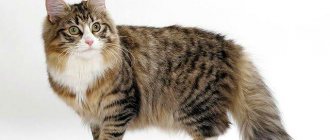What do we know about cats?
Photo: unsplash.com
1. According to popular belief, cats have nine lives. 2. Having fallen from any height, they always land on their paws. 3. Able to jump from a place to a height of up to 5 m. 4. Can see in the dark. 5. Cats cannot distinguish sweet tastes.
Despite the large number of well-known little things in the life of cats, they are still capable of surprising and remaining mysterious creatures.
While people specifically domesticated dogs, cats domesticated themselves
Dogs were one of the first domesticated animals. It is believed that hunter-gatherers kidnapped wolf cubs and raised them as hunting companions.
As for cats, they were mostly domesticated on their own. After people began to engage in agriculture and lead a sedentary lifestyle, they had to learn to store large reserves of grain in warehouses and primitive silos.
And if a lot of grain is stored in one place, then any farmer will tell you that eventually hordes of rats will come there. Thanks to this amount of food - rodents - cats gradually adapted to life next to people, became more open and trusting, and eventually became domesticated.
People tolerated cats because they hunted rats and thus helped store grain, and cats tolerated people because human granaries were always full of food for every taste.
Domestication is believed to have occurred in Mesopotamia and Ancient Egypt, leading to the deification of cats in these societies.
Interesting facts about cats
Hearing
Cats hear over a wider range than humans or dogs. Cat ears are constantly in motion - even if the animal is sleeping, its ears pick up the slightest rustle. This is why it is so difficult to take a cat by surprise. And a cat's ambush on mice makes sense, because... mice communicate with each other in the ultrasonic range, which is clearly audible to cats over long distances.
Vision
Cats have binocular vision, their eyes are large and allow them to see what is happening on the sides. The viewing angle is 287 degrees. There is a third eyelid - a light white film in the corner of the eye that protects and moisturizes the eyeball.
The structure of the eye contains a special substance called tapetum, which is capable of reflecting light and providing night vision. Thanks to this, the cat's eyes seem to glow in the dark.
Meow
The mystery of a cat's meow has not yet been solved. They do not make any sounds when communicating with each other. They can purr to show that they like something. Meowing itself is used only in communication with a person, to attract his attention.
Smell
Cats constantly lick their fur. This is due not only to the cleanliness of the pet, but also to the fact that this is how they remove foreign odors from themselves. They are hunters, it is important for them not to smell anything, so if you pet a cat, it will immediately begin to lick off the smell of your hands.
Rest
Photo: unsplash.com
Those who have a cat at home know that she sleeps most of the day. Scientists, after conducting a series of experiments, found that all cats sleep at least 16 hours a day. Which is about 70% of a cat's life. This is explained by the fact that all cats are hunters, and lazy rest allows them to waste less energy needed to catch prey.
Here are some more interesting facts about cats that you might not know:
- There are more than 500 million domestic cats in the world. The most cat-like country is Australia. There are 9 cats for every 10 people.
- Cats smell 14 times more strongly than humans.
- Cats can only sweat through the pads of their paws. They do not have sweat glands on other parts of their body. The normal body temperature of a cat is 38 - 39.5 degrees.
- Cats have an average of 12 movable whiskers, which contain many nerve endings. With the help of its whiskers, the cat receives information about everything that surrounds it.
- Each cat has a unique pattern on its nose. It is as individual as people's fingerprints. If a cat's tail trembles near you, this is the greatest feeling of love that it can express to you. Cats rub against human feet to cover up other people's odors.
- When a person pets a cat, his pulse and blood pressure decrease.
- Cats typically live up to 20 years, which is equivalent to 96 years of human age.
The most famous cats in the world
Of course, in the cat genus there are outstanding specimens that have gained worldwide fame. Some of them have pages on Instagram, Twitter and other social networks with thousands and even millions of subscribers. Some of the most famous are:
- Persian cat Garfi. He became famous thanks to his expressive appearance. He is known online as the angriest cat because of his look and dark, angry appearance.
- Sam of the Khao Mani breed. He has over 200,000 followers on Instagram. He is known for his muzzle, which seems to have black eyebrows painted on it. This pet brought its owners many tens of thousands of dollars.
- Cat Monty or Noseless. A peculiarity of the animal is the absence of a nasal bone, which makes its appearance strange, but not without charm.
- A Venus cat with a rare genetic trait called a “chimera.” Until recently, she was extremely popular on the Internet, which became possible thanks to her interesting color - her muzzle seems to be divided into two halves, one of which is pure black, and the second is red. The cat is also distinguished by heterochromia - its eyes are different colors, green and blue.
- Cat Meow. It is a mixture of Persian and Himalayan breeds. Known as the fluffiest shaggy cat on the Internet.
There are other cats that have gained their fame and made their owners richer. Such cats not only brought tenderness and affection into the home, but also significantly improved the financial situation of their owners.
№3
The human body has 206 bones, while cats have 230. Additional bones in the spine and tail give these animals better flexibility. Also, due to the specific structure of the bones, they can easily pass through narrow spaces. In particular, this is caused by the absence of a collarbone and a small rib cage.
№5
We all know that they love to hide in small places, especially boxes. But what causes this strange behavior? Scientists have several assumptions about this. The first is that they feel more protected in confined spaces, such as boxes. Second, when an animal sleeps in a small box, it retains more heat than if it slept outside or in a large room.
Habitats
This animal prefers remote places where no human foot can tread. It can be found in forests where there is dense undergrowth or high in the mountains where there are not many other animals.
Also, a forest cat will not live in areas where there is a lot of snow in winter, and it lies in a thick layer, because in this case, they will not be able to get food for themselves. In winter, in severe cold, it can be found near people's homes. The tailed one comes to get food.
Miracle healers?
Cats are often called psychics and “whiskered healers.” There are people who are convinced that these animals are able to cure many diseases, as they have some kind of paranormal abilities. There are even special guides that tell what breeds of cats are capable of healing certain ailments and in what places to put them in order to be cured...
We will not judge whether this is all true or something from the realm of mythology. But some facts about cats have actually been confirmed by professional scientists and doctors. Here is a list of them.
№1
They spend 30 to 50% of their active time grooming themselves. This behavior serves several purposes: washes help them remove strong odors that could attract predators, help stimulate blood flow, and help distribute oils evenly throughout their coat to keep them dry and warm.
Also, the animal's saliva contains enzymes that serve as a natural antibiotic for wounds, allowing them to heal faster.
Hunting for a laser pointer causes mental trauma to a cat
Cat owners know that there is no better game for their pet than “hunting” for a laser pointer or a sun bunny. Although the light spot or laser trail does not even remotely resemble mice or other prey, their unpredictable, fast movements awaken cats' hunting instincts and an irresistible desire to give chase, which is ultimately doomed to failure.
Ethologists (animal behavior specialists) are confident that frequent “hunting” for a laser pointer or a sun “beam” can be harmful to a cat precisely because of the elusiveness of “game”.
Nicholas Dodman
“Chasing a spot of light is so exciting for cats that they can’t stop – it becomes a habit, but the result is unattainable, and the ‘unsuccessful chase’ provokes mental trauma,” Professor Nicholas Dodman, a member of the School of Veterinary Medicine, explained in an interview with Live Science magazine. at Tufts University (Massachusetts).
By the way, recently experts conducted a study that revealed some similarities between the pathology of cats’ endless “hunting” for laser pointers and people’s addiction to TV: in both cases, attention is tenaciously captured by the movements of light.
№10
They naturally need to scratch with their claws. And yes, this irritates the owners, especially if they scratch the wallpaper or expensive furniture. However, scratching plays an important role in the life of the animal. Firstly, it helps the animal sharpen its claws, and secondly, it stretches the muscles of the back and shoulders, which do not stretch during normal stretching.
Appearance
External differences between a wild forest cat and its domestic counterpart are virtually invisible. The weight of a wild forest cat reaches 7 kg. But some species can reach quite large sizes - up to 15 kg. The body length reaches 90 cm. Actually, the size of the cat very much depends on its habitat and time of year. Any wild cat weighs much more in summer than in winter, since it gains fat over the summer.
The ears of a wild cat are set wide apart and mobile. The claws easily retract into the paws. The forest cat's vision is very good. The mouth is equipped with sharp fangs that are good at capturing and holding game. The molars are strong enough to chew caught prey.
Central European forest cats shed twice in spring and autumn, but in winter their fur is much thicker in order to protect the animal from severe frosts.











